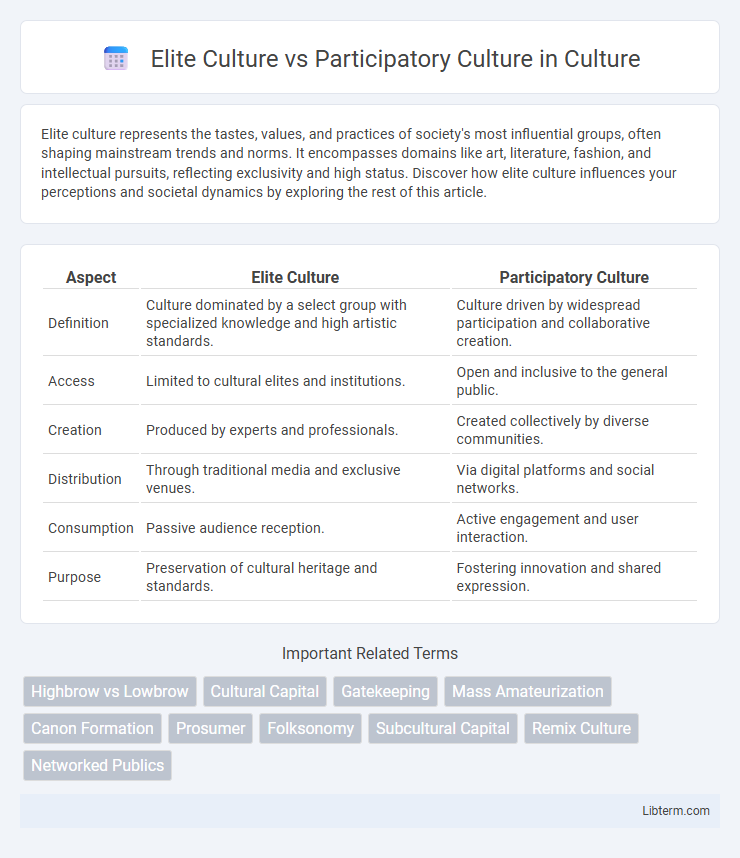Elite culture represents the tastes, values, and practices of society's most influential groups, often shaping mainstream trends and norms. It encompasses domains like art, literature, fashion, and intellectual pursuits, reflecting exclusivity and high status. Discover how elite culture influences your perceptions and societal dynamics by exploring the rest of this article.
Table of Comparison
| Aspect | Elite Culture | Participatory Culture |
|---|---|---|
| Definition | Culture dominated by a select group with specialized knowledge and high artistic standards. | Culture driven by widespread participation and collaborative creation. |
| Access | Limited to cultural elites and institutions. | Open and inclusive to the general public. |
| Creation | Produced by experts and professionals. | Created collectively by diverse communities. |
| Distribution | Through traditional media and exclusive venues. | Via digital platforms and social networks. |
| Consumption | Passive audience reception. | Active engagement and user interaction. |
| Purpose | Preservation of cultural heritage and standards. | Fostering innovation and shared expression. |
Defining Elite Culture and Participatory Culture
Elite culture refers to cultural practices, values, and artifacts associated with a select, often privileged group distinguished by high social status, education, and refined tastes, such as classical music, fine arts, and literature recognized by cultural institutions. Participatory culture emphasizes widespread involvement and engagement, where individuals actively create, share, and collaborate on content across digital platforms, fostering collective creativity and democratic access to cultural production. The distinction lies in elite culture's top-down, expert-driven approach versus participatory culture's bottom-up, user-generated dynamic promoting inclusivity and shared authorship.
Historical Origins of Elite and Participatory Cultures
Elite culture traces its origins to ancient hierarchical societies where cultural knowledge and artistic expression were controlled by aristocrats and intellectual elites, preserving exclusivity through formal institutions such as academies and royal patronage. Participatory culture emerged prominently in the 20th century alongside technological advancements like radio, television, and the internet, enabling mass involvement and democratization of cultural production and consumption. This shift empowered ordinary people to actively create and share content, challenging traditional elite-controlled cultural narratives.
Key Characteristics of Elite Culture
Elite culture is characterized by high intellectual standards, exclusivity, and a focus on classical arts such as literature, opera, and fine arts, which are often accessible primarily to educated and affluent audiences. It emphasizes formal training, mastery, and the preservation of tradition, with cultural products often considered symbols of social status and refined taste. This contrasts with participatory culture, where inclusivity, collaboration, and a broad range of media forms encourage widespread engagement and collective creativity.
Key Characteristics of Participatory Culture
Participatory culture is characterized by low barriers to artistic expression and civic engagement, enabling broad community involvement and collaborative content creation. Members of participatory cultures actively produce, share, and remix media, fostering collective intelligence and decentralized authorship. This culture promotes social connectivity, diversity of expression, and grassroots innovation in digital environments.
Power Dynamics and Accessibility
Elite culture often centralizes power within privileged groups, limiting access to cultural production and reinforcing hierarchical control over narratives and resources. Participatory culture democratizes power by enabling wider community involvement in content creation, fostering inclusivity and diverse voices through accessible technology platforms. This shift reduces barriers to entry, empowering individuals to challenge dominant norms and contribute to cultural discourse on equal footing.
Influence on Arts, Media, and Knowledge Production
Elite culture shapes arts, media, and knowledge production by emphasizing high artistic standards and expert-driven content, often favoring traditional forms and specialized audiences. Participatory culture transforms these domains through active community involvement, fostering collaboration, user-generated content, and democratized access to information. This shift enhances diversity in creative expression, challenges hierarchical gatekeeping, and accelerates innovation across cultural industries.
Technology’s Role in Cultural Evolution
Elite culture historically relied on limited access to technology, shaping cultural evolution through controlled dissemination of art and knowledge via institutions like museums and universities. Participatory culture thrives on digital technologies, enabling mass collaboration, content creation, and sharing across platforms such as social media, online forums, and video streaming services. The rapid advancement of internet technologies accelerates cultural democratization, shifting power from traditional gatekeepers to diverse communities engaged in cultural production and innovation.
Social Inequality and Cultural Gatekeeping
Elite culture often reinforces social inequality through exclusive access and stringent cultural gatekeeping, limiting participation to privileged groups. Participatory culture challenges these barriers by promoting inclusivity, democratizing cultural production, and enabling diverse voices to contribute. This shift reduces hierarchical control, fostering greater cultural equity and social mobility.
Case Studies: Real-World Examples of Both Cultures
Elite culture is exemplified by traditional institutions such as the Metropolitan Opera and the Louvre Museum, where exclusive access and specialized knowledge define audience engagement. Participatory culture thrives in platforms like YouTube and TikTok, where users actively create, share, and remix content, fostering collaborative creativity and community interaction. Case studies of these cultures highlight how elite culture maintains hierarchical consumption, while participatory culture emphasizes democratized production and collective participation.
Future Trends: Toward Hybrid Cultural Models
Future trends in cultural dynamics point toward hybrid models that blend elite culture's exclusivity with the accessibility of participatory culture. Digital platforms and emerging technologies enable wider audience engagement while preserving high-quality artistic standards, fostering collaborative creativity and diverse content creation. This convergence promotes more inclusive cultural ecosystems that balance professional expertise with grassroots innovation.
Elite Culture Infographic

 libterm.com
libterm.com